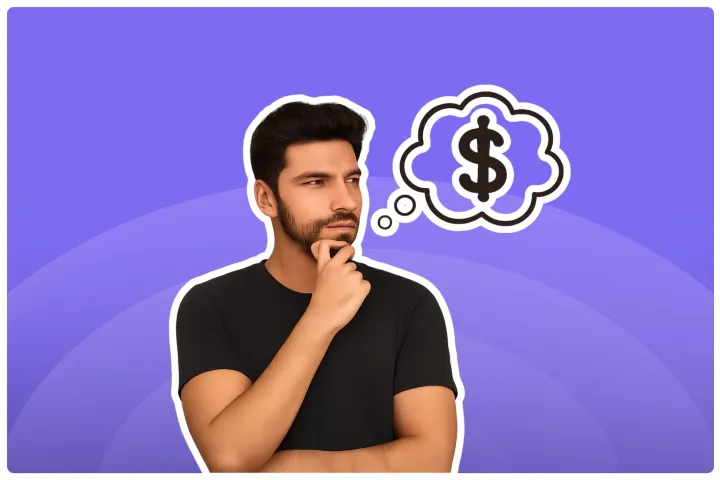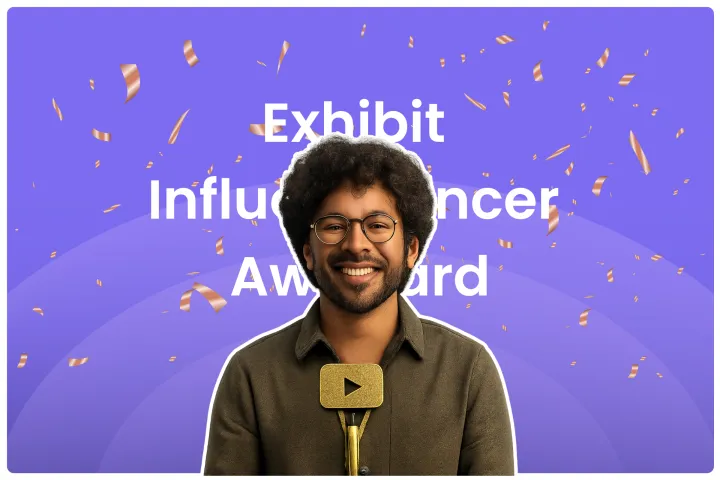Who Has The Most Fake Followers On Instagram In India
Who's faking it on Instagram in India? Explore our analysis of the influencers with the most fake followers and see how it impacts their credibility!

You might have noticed it – a sudden spike in followers but no matching jump in likes or comments. Or maybe you've seen accounts with massive numbers but suspiciously low engagement. It’s a confusing situation, and honestly, it’s a bigger deal in India than many of us realize.
But hey, don't let it get you down! Think of this chat as your friendly guide – your mentor in navigating this tricky aspect of the influencer journey. We're going to break down what fake followers are, understand the real impact they have (especially here in India), and most importantly, figure out how you can protect your hard-earned authenticity and thrive. We'll even look at how platforms like ryme.ai are stepping up to support genuine creators like you. Ready to tackle this together? Let's dive in! 💪
Understanding Fake Followers
Alright, first things first. What exactly are we talking about when we say "fake followers"? It’s not just one thing, but generally falls into these categories:
1) Bots: These are the most straightforward fakes. Think of them as robots, not real people. They are automated accounts created by software, often in huge numbers. Their goal isn't to enjoy your amazing content; it's usually to inflate follower counts or sometimes even spread spam. They don't engage meaningfully (no genuine comments, no shares because they loved your Reel, definitely no purchases!).
You can often spot them by their weird usernames (like "user123abc789"), lack of profile pictures, or having zero posts themselves.
2) Inactive Accounts: These might be real accounts created by real people at some point, but they've gone dormant. Maybe someone created an account ages ago and forgot the password, or they just stopped using Instagram. While not technically "fake" in the way bots are, they don't contribute to your engagement either. They just sit there, adding to your follower number but not interacting. They won't see your posts, like your Reels, or click your links.
3) Purchased Followers: This is where things get intentionally murky. Some people or services sell followers in bulk. You pay a fee, and boom! Your follower count jumps. These purchased followers are almost always bots or inactive accounts. Buying followers is a big no-no 🙅♀️ because it directly undermines authenticity and is easily detectable by brands and platforms. It's like building a house on sand – it looks big, but it has no real foundation.
Impact on Engagement: Why Numbers Aren't Everything
Okay, so you have these bots, inactive accounts, or maybe even purchased followers hanging around. Why is it a problem? Because engagement is the real currency of influence!
Think about it: Brands collaborate with you because they want to reach your audience – real people who trust you, interact with your content, and might be interested in their products or services. Fake followers don't do any of that.
Skewed Metrics: Your engagement rate (ER) is a key metric brands look at. It's usually calculated like this: (Total Likes + Total Comments) / Total Followers * 100% If a large portion of your "Total Followers" are fake, your denominator is artificially inflated. This means even if your real followers are engaging like crazy, your overall ER will look lower than it should.
A 100k account with 60k fake followers only has 40k real potential engagers. If 2k people engage, the real ER is 5% (2k/40k), which is pretty good! But the apparent ER is only 2% (2k/100k), which might look low to a brand.
Misleading Brands: High follower counts with low engagement are a huge red flag for brands. They use tools to analyze influencer profiles, and if they see a mismatch, they'll assume the audience isn't genuine or engaged. This can lead them to pass you over for collaborations, even if you have a loyal core following. They want results, not just numbers.
Wasted Potential: Those fake followers aren't just numbers; they represent missed opportunities for real connections and real impact.
Detection Methods: Spotting the Fakes
So, how do you know if you have fake followers? And how do brands check? There are tools and techniques:
1) Influencer Audit Tools: Platforms like Upfluence and Modash offer tools (some even have free checkers!) that analyze follower lists for suspicious patterns.
Brands often use sophisticated platforms like ryme.ai (a major player in India) to get deep insights into an influencer's audience quality before collaborating.
These tools look for bots, inactive accounts, mass followers (accounts following thousands of others), and geographic mismatches.
2) Manual Checks (Things You Can Do!):
- Look at Follower Profiles: Take a random scroll through your followers list. Do you see lots of accounts with no profile picture? Blank bios? Weird, nonsensical usernames? Only one or two generic posts (or none at all)? These are potential red flags.
- Check Engagement Quality: Look at your comments. Are they genuine and relevant to your post, or just generic things like "Nice pic," "Great," or random emojis? Bot comments are often repetitive and meaningless.
- Monitor Follower Growth: Did your follower count suddenly jump by thousands overnight without a viral post or major press mention? Unnatural spikes are often a sign of bought followers or a bot attack.
Genuine growth is usually more gradual and steady. (Example: Riya noticed a sudden jump of 5k followers after a small brand collab, but her likes didn't increase. She used a free checker and found a high percentage of suspicious accounts, likely bots added by a less-than-ethical service the brand might have used.)
3) Analyze Engagement Rate: Keep an eye on your ER. Is it consistently very low compared to other creators in your niche with a similar follower count? This could indicate a high number of inactive or fake followers dragging the average down.
Understanding these aspects is the first step to taking control and focusing on what truly matters: building a real, engaged community. 😊
The Scale of the Fake Followers Problem in India
Now, let's zoom in on the situation right here in India. You might be surprised (or maybe not!) to hear that the issue of fake followers isn't just a small annoyance; it's a significant challenge impacting the entire influencer marketing industry.
Statistics: The Hard Numbers
Recent analyses paint a pretty stark picture. KlugKlug, an influencer marketing tech platform widely used by brands in India, has audited millions of profiles. Here’s what they found (based on reports from mid-2024 and early 2025):
- Widespread Issue: Kalyan Kumar, CEO of KlugKlug, stated that "Two out of three influencers have more than 50 percent inactive or fake followers." Let that sink in – a majority of profiles might have more fakes than real, active followers! 🤯
- Credibility Gap: In an audit of 8 million Indian influencer profiles, KlugKlug found that only 2.48 million exhibited credible and high-quality followers. The rest? Their followers consisted of around 60% bots on average.
- India as a Hub: Sadly, reports highlight that India has become the world's largest consumer and generator of fake followers, surpassing countries like Russia, Brazil, and Indonesia. It's incredibly easy and cheap to buy fake followers here, sometimes costing as little as ₹10-15 for thousands.
- The Gender Mismatch: KlugKlug also pointed out a "great gender mismatch tragedy," particularly in the beauty niche. They found that about 84% of female beauty influencers have 70% to 80% male followers. While Instagram's user base in India is predominantly male, this huge skew raises questions for brands targeting female consumers through these influencers. Are they reaching the right audience?
These numbers aren't meant to scare you, but to highlight the reality we're operating in. It shows just how crucial authenticity and verification have become.
Industry Implications: Why It Matters to All of Us
This widespread issue of fake followers has serious consequences for the Indian influencer marketing industry, which is a booming sector. Reports from 2024-2025 value the industry at over ₹2,500 crore and project strong annual growth (around 25%). However, fake followers threaten this growth:
- Wasted Brand Budgets: Brands are pouring significant money into influencer marketing. KlugKlug's CEO estimated that "Almost every brand is wasting a flat 40% of their money with these influencers who have more than 60% of fake followers on average." That's a massive amount of marketing spend going down the drain, paying for reach that simply doesn't exist. 💸
- Increased Brand Skepticism: As brands become more aware of the fake follower problem (and experience poor ROI from campaigns with inauthentic influencers), they naturally become more cautious. Reports indicate that many lifestyle and beauty brands are rethinking their strategies. They are moving away from just looking at large follower counts and focusing more on engagement rates, content quality, and audience authenticity.
- Shift Towards Micro/Nano Influencers: This caution often leads brands to prefer working with micro-influencers (typically under 100k followers) or even nano-influencers (under 10k). They believe these creators often have smaller but more genuine and engaged communities, offering better value and more authentic reach, even if the numbers are smaller. This can be good news for smaller creators, but it highlights the trust deficit with larger accounts suspected of having fake followers.
- Damage to Industry Credibility: When fake followers are rampant, it casts doubt on the entire influencer marketing channel. It makes it harder for everyone, including genuine creators with authentic followings, to prove their value and build trust with brands. The actions of a few (or many) using fake followers hurt the reputation of the whole community.
Understanding the scale of this problem in India helps us see why focusing on genuine growth and engagement isn't just a 'nice-to-have'; it's essential for the long-term health and sustainability of our careers as creators and for the industry as a whole.
Who Are the Culprits?
Okay, so we know fake followers are a big issue in India. But who is actually using them? Is it just a few bad apples, or is it more widespread?
Top Influencers with Fake Followers: The General Picture
It’s tricky, and honestly risky, to point fingers and name specific individuals without concrete, verified proof from audits (which are rarely made public with names). Platforms like KlugKlug release statistics about the percentage of influencers affected, but they typically don't publish "lists of shame."
However, the data we discussed gives us some strong clues:
It's Widespread: Remember the KlugKlug stat: "Two out of three influencers have more than 50 percent inactive or fake followers." This suggests the problem isn't limited to just a handful of creators but affects a significant portion of the influencer pool, potentially across various follower count tiers.
Focus on Indicators, Not Just Names: Instead of asking who, it's more productive to ask what kind of profiles often raise red flags. These might include:
- Accounts with incredibly rapid, almost overnight follower growth that doesn't match their content's virality or engagement levels.
- Profiles with huge follower counts but consistently low likes, comments, and shares.
- Influencers whose audience demographics (like location or gender, remember the beauty influencer example) seem completely mismatched with their content niche or target audience.
- Accounts where the comment sections are filled with generic spam rather than genuine conversation.
The Temptation: The pressure to show large numbers can be intense. Some creators might feel tempted to buy followers to look more attractive to brands, especially when starting out or feeling stagnant. The low cost (₹10-15 for thousands, as mentioned) makes it accessible, unfortunately.
The key takeaway isn't about creating a witch hunt, but recognizing that the problem is prevalent enough that all influencers need to be mindful of audience quality – both their own and potentially that of others in the space.
Industries Most Affected: Where is it More Common?
While fake followers can pop up anywhere, some industries seem to be more affected than others, according to reports and industry observations:
1) Beauty and Fashion: These sectors are frequently highlighted (as per the Mint and exchange4media reports). Why?
2) Highly Visual: Success often relies on stunning visuals (photos, Reels), which might initially attract followers but doesn't guarantee sustained engagement if the connection isn't deeper.
3) Aspirational Content: These niches often sell a lifestyle or look, making high follower counts seem particularly important for projecting success and desirability.
4) Intense Competition: It's a crowded space, and the pressure to stand out with big numbers might lead some down the wrong path.
5) Product Seeding: Brands often send free products, and some influencers might inflate numbers to get more freebies, even if they don't have a genuinely engaged audience to promote to.
6) Lifestyle: This broad category is also mentioned as being cautious due to fake followers (Mint). Similar pressures regarding competition and perceived influence likely apply.
7) Entertainment/Celebrity: While established celebrities often have massive organic followings, even their accounts aren't immune to accumulating bots and inactive followers over time. The sheer scale means even a small percentage of fakes can represent a large absolute number.
It's less about specific industries being inherently "bad" and more about where the pressures and incentives to inflate numbers might be highest. Understanding this helps everyone – creators and brands – be more vigilant.
Consequences of Fake Followers
So, we've established that fake followers are out there, and it's a significant issue. But what are the actual, tangible consequences? They ripple outwards, affecting both the brands who invest in influencers and the genuine creators trying to build authentic careers.
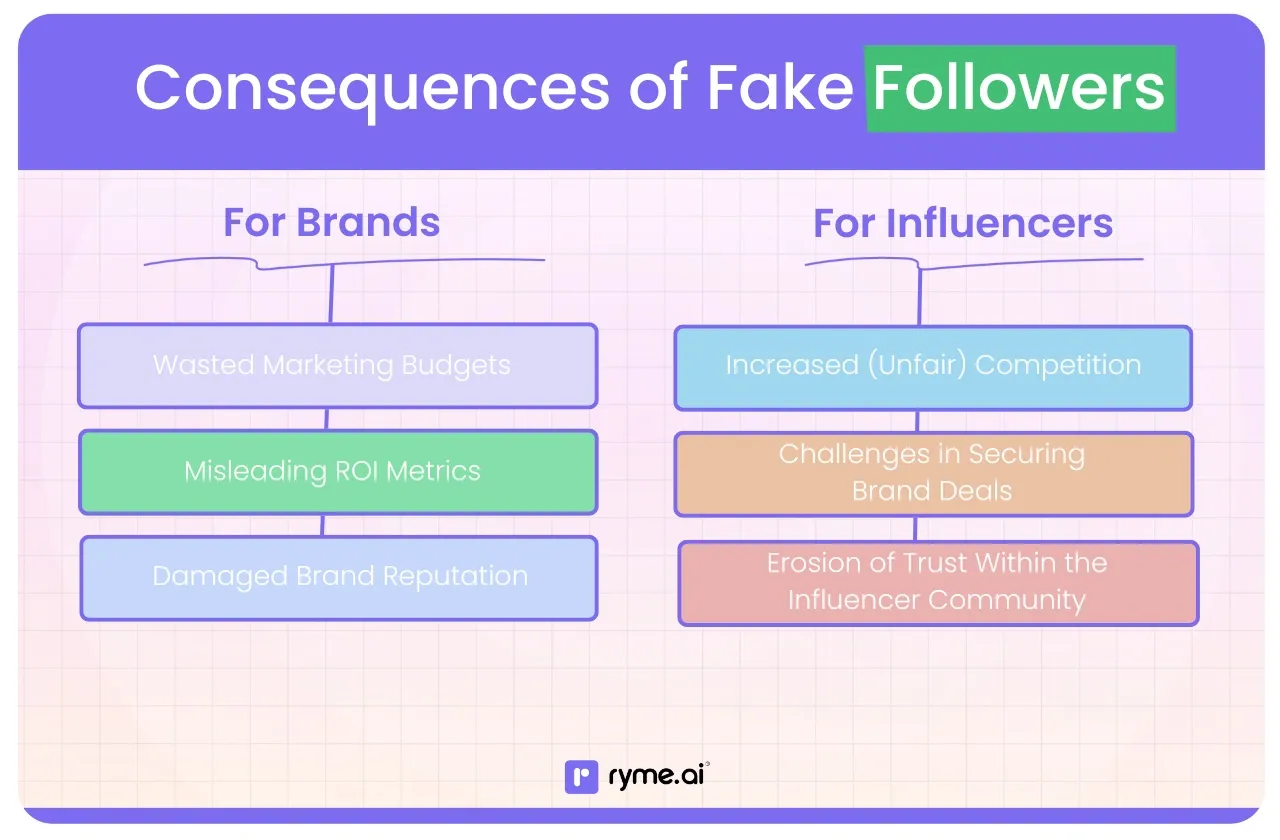
For Brands: Money Down the Drain & Reputation Risk 😟
When brands partner with influencers who have a high percentage of fake followers, they face several negative outcomes:
1) Wasted Marketing Budgets: This is the most direct hit. Brands allocate budgets (sometimes substantial ones!) expecting to reach a certain number of potential customers through an influencer's audience. If 60% of that audience is fake, 60% of the money spent on that collaboration is essentially wasted. They are paying for eyeballs that don't exist or don't care. Imagine a brand paying ₹50,000 for a campaign hoping to reach 200,000 people, but 120,000 of those are bots – they've effectively thrown ₹30,000 away.
2) Misleading ROI Metrics: Campaigns might initially look successful on paper based on inflated reach numbers. But when the brand looks deeper, they find the campaign didn't translate into actual results – website visits, sign-ups, sales, or even genuine brand awareness. The Return on Investment (ROI) calculations become skewed and unreliable, making it hard for the brand to justify future influencer marketing spend or understand what really works.
3) Damaged Brand Reputation: Consumers are getting savvier. If a brand consistently partners with influencers who are obviously padding their numbers or have very low engagement, it reflects poorly on the brand itself. It can make the brand look naive, desperate, or even complicit in inauthentic practices. Associating with fakes can erode consumer trust in the brand's judgment and authenticity.
For Genuine Influencers: An Uphill Battle 🧗♀️
The prevalence of fake followers doesn't just hurt brands; it creates significant challenges for creators who are doing things the right way:
1) Increased (Unfair) Competition: Imagine you've spent years building a loyal community of 20k engaged followers. Then, someone else in your niche buys 80k fake followers overnight, suddenly appearing 'bigger' with 100k. Some less sophisticated brands might be swayed by the larger number, giving opportunities to the fake influencer that you, with your genuine engagement, might have deserved. It feels unfair, and it is.
2) Challenges in Securing Brand Deals: As brands become more aware and start using audit tools, any influencer with a high percentage of fake followers (even if not intentionally bought) can get flagged. You might accumulate bots or inactive followers naturally over time. If you aren't actively monitoring and cleaning up your audience, you could be filtered out by brands looking for high-quality, authentic reach, even if your core audience is fantastic.
3) Erosion of Trust Within the Influencer Community: When authenticity is questioned, it creates a climate of suspicion. Brands might become hesitant to trust any influencer's numbers. It can also damage relationships between creators if there's a perception that some are 'cheating the system'. It undermines the value of genuine influence and makes it harder for everyone to build trust-based partnerships.
The bottom line? Fake followers create a lose-lose situation in the long run. They waste brand resources and make it significantly harder for genuine influencers to get recognized and rewarded for their authentic hard work and community building. This underscores why prioritizing authenticity isn't just ethical; it's also smart business for creators.
How to Protect Yourself as an Influencer
Okay, we've talked a lot about the problem. Now for the empowering part: what can you do about it? As a creator focused on building something real and lasting, you have more control than you might think. Here’s how you can protect your authenticity and build a profile that stands out for the right reasons:
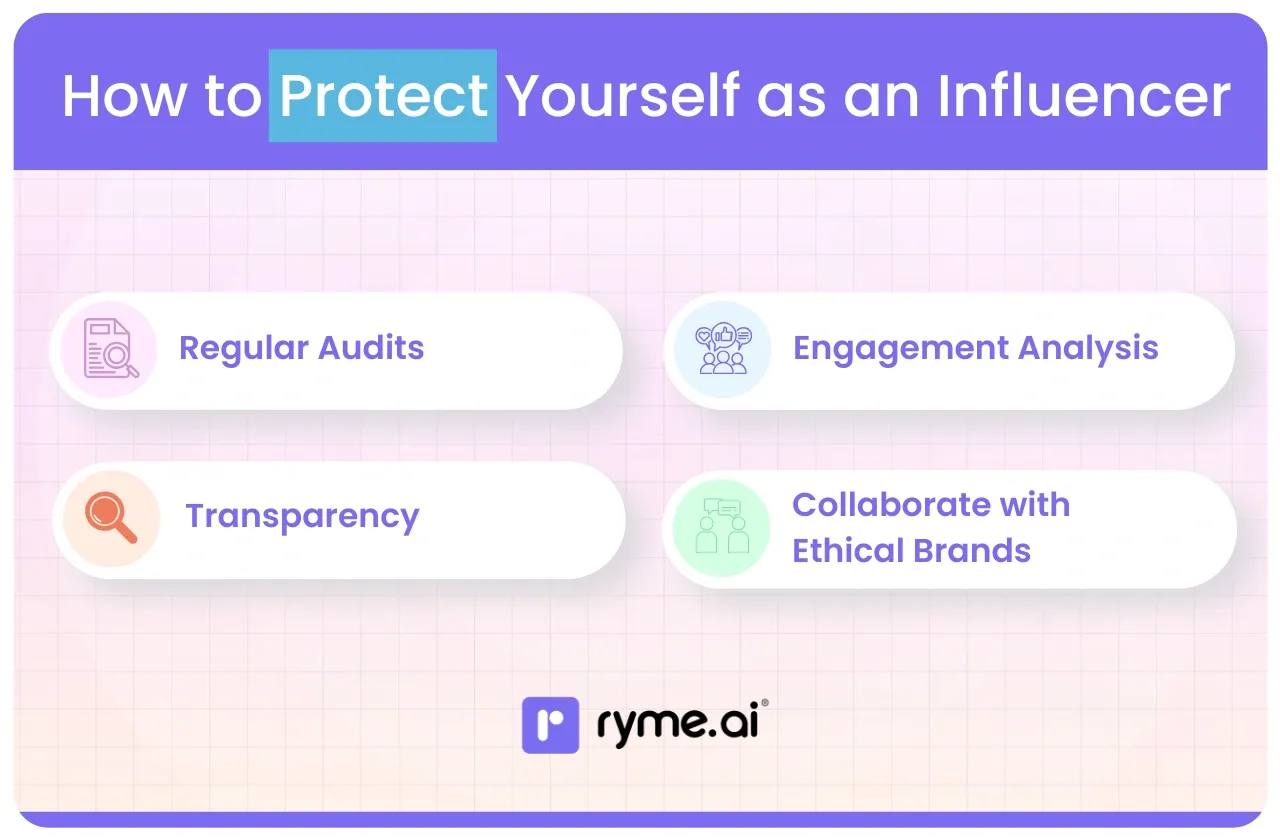
1) Regular Audits: Be Your Own Watchdog 🕵️♀️
Don't wait for a brand to flag your account; be proactive! Regularly checking the health of your follower base is crucial.
- Use Available Tools: Explore free fake follower checkers offered by platforms like Modash or Upfluence. They can give you a quick snapshot of the estimated percentage of suspicious accounts. While not always 100% perfect, they provide a useful indicator.
- Manual Spot Checks: Dedicate some time every month or so to scroll through your recent followers list. Look for those red flags we discussed: no profile pic, weird usernames, zero posts, accounts following thousands but having few followers.
- The Clean-Up: Don't be afraid to block and remove suspicious-looking accounts. Yes, your follower count might dip slightly, but it's far better to have a smaller, genuinely engaged audience than a large, inflated one. Think of it as pruning a plant – removing the dead leaves helps the healthy parts grow stronger! 🌱
2) Engagement Analysis: Dive Deeper Than Likes ❤️📊
Your analytics are your best friend! Go beyond just the surface numbers.
- Track Your Real Engagement Rate (ER): Calculate it based on your average likes and genuine comments (ignore the spam!). Compare it over time and see how it stacks up against benchmarks for your niche and follower size. A healthy ER is a strong sign of an authentic audience.
- Look at Comment Quality: Are people leaving thoughtful comments related to your content? Are you having actual conversations? This is far more valuable than a hundred generic "🔥" emojis from bots.
- Monitor Watch Time & Shares (for Videos/Reels): These metrics show that people are actually consuming and valuing your content enough to share it. High shares are a fantastic indicator of genuine impact.
- Check Follower Growth Patterns: Use Instagram Insights or third-party tools to look at your follower growth graph. Is it relatively steady with occasional bumps from great content, or are there sudden, massive, unexplained spikes? Steady growth usually indicates organic reach.
Example: Let's say Sunil, a food blogger, noticed his ER dipping despite posting regularly. He dug into his analytics and saw decent likes but very few saves or shares on his recipes. He started asking specific questions in his captions ("What ingredient would YOU add?") and replying to more comments. His ER improved, and brands noticed the increased interaction.
3) Transparency: Honesty is the Best Policy ✅
Be open and honest, both with yourself and with potential brand partners.
- Focus on Quality Metrics: When talking to brands, don't just lead with your follower count. Highlight your engagement rate, the quality of interactions, audience demographics (if they align well with the brand), and maybe even share case studies of past successful campaigns that drove real results (like website clicks or sales).
- Build Community, Not Just Numbers: Let your content and interactions show that you care about your followers. Run polls, ask questions, go live, respond to DMs and comments genuinely. When brands see an active, thriving community, they're less likely to worry about fake followers.
- Address Concerns Head-On: If a brand raises questions about your audience quality, be prepared. If you've been doing regular audits, you can confidently explain your process for maintaining an authentic following.
4) Collaborate with Ethical Brands: Choose Your Partners Wisely 🤝
Seek out brands that value what you value: authenticity.
- Look for Brands That Ask the Right Questions: Brands that inquire about your engagement rates, audience demographics, and past campaign results (beyond just reach) are likely more sophisticated and value genuine influence.
- Value Brands Using Verification: If a brand mentions they use tools like KlugKlug or others to vet influencers, see it as a positive sign! It means they care about authentic partnerships and are likely weeding out the fakes.
- Trust Your Gut: If a brand seems solely focused on getting the highest follower count for the lowest price, or if their practices seem sketchy, it might be best to walk away. Partnering with ethical brands protects your own reputation too.
By taking these steps, you shift the focus from vanity metrics to true value. You build a stronger, more resilient influencer brand based on real connection and impact – something that no amount of fake followers can replicate. ✨
How ryme.ai Supports Influencers in Building Authenticity
ryme.ai is an AI-powered influencer marketing platform based right here in Bengaluru. ryme.ai helps influencers of all sizes – from nano and micro-influencers just starting to build momentum, to macro-influencers with larger followings, and even UGC (User-Generated Content) creators who might not have huge numbers but excel at creating authentic content.
The core mission is to make influencer marketing more effective, transparent, and accessible, focusing on genuine connections and measurable results rather than just vanity metrics. This inherently aligns with the need for authenticity in the face of fake followers.
Features Beneficial for Influencers: How ryme.ai Helps YOU Shine ✨
So, how does ryme.ai actually help you, the creator, build an authentic and sustainable career? Here are some key features highlighted in their platform descriptions:
1) Steady Income through Smart Collaborations:
- ryme.ai uses AI to match you with brand campaigns tailored to your specific style, niche, and audience. This means you're more likely to find collaborations that genuinely resonate with your followers, leading to more authentic promotions.
- The focus is on finding the right fit, not just any deal. This helps you maintain credibility with your audience. They might also offer recurring deals, providing a more predictable income stream compared to one-off campaigns.
2) Instant Payments & Zero Commission:
- Say goodbye to chasing payments! 👋 ryme.ai emphasizes instant payouts right after you complete your campaign deliverables.
- They also highlight zero subscription fees or hidden costs for creators. This transparency means you keep what you earn, allowing you to focus on creating great content without worrying about delayed payments. 💰
3) Effortless Campaign Management & Quick Approvals:
- The platform provides a centralized space to manage all your collaborations. You can browse opportunities, apply, submit content for approval, track progress, and communicate – all within the app.
- This streamlined workflow saves you time and hassle compared to juggling endless emails and DMs. Faster content approvals mean you can complete campaigns more efficiently.
4) Performance Analytics & Data-Driven Insights:
- ryme.ai provides detailed analytics on your campaign performance. You can see what resonates with your audience, understand your impact, and track metrics beyond just likes.
- These insights empower you to optimize your content strategy and demonstrate your real value to brands using concrete data. This is crucial for proving authenticity and effectiveness. 📈
6) Commitment to Authenticity & Genuine Opportunities:
- By connecting creators with verified brands for genuine campaigns, ryme.ai fosters an ecosystem built on trust.
- Their emphasis on User-Generated Content (UGC) also shows they value authentic content creation, even from those without massive follower counts. This levels the playing field, allowing talent and authenticity to shine through.
- By facilitating meaningful collaborations based on fit and performance rather than just follower numbers, ryme.ai indirectly reduces the perceived need for fake followers and supports creators who focus on building real influence.
- Platforms like ryme.ai represent a positive shift in the industry – moving towards data-driven, transparent, and authentic collaborations. For creators tired of the noise and seeking genuine partnerships and reliable income, exploring such platforms could be a game-changer.
Conclusion: Your Authenticity is Your Superpower 💪
Okay, creators, we’ve covered a lot! From understanding the different types of fake followers (bots, inactive accounts, purchased ones) to seeing the scale of the problem right here in India, and the consequences it has for both brands and us genuine influencers. It's clear that navigating this landscape requires awareness and action.
The key takeaway? Your authenticity is your most valuable asset. ✨ In an industry grappling with fake numbers, genuine connection, real engagement, and trustworthy content stand out more than ever. Brands are getting smarter, tools are getting better, and the focus is shifting towards quality over mere quantity.
Don't let the existence of fake followers discourage you. Instead, let it motivate you to double down on what makes you unique:
- Build Your Community: Focus on fostering real relationships with your audience. Talk with them, not at them.
- Create Value: Produce content that your followers genuinely enjoy, learn from, or connect with.
- Be Proactive: Regularly audit your followers and analyze your engagement. Know your numbers – the real ones!
- Partner Wisely: Collaborate with ethical brands and platforms like ryme.ai that value authenticity and offer transparent, fair opportunities.
Remember, building a successful and sustainable career as an influencer is a marathon, not a sprint.
Shortcuts like buying followers might offer a temporary illusion of success, but they ultimately undermine your credibility and longevity. Investing in your authentic voice and community is the surest path to lasting impact and reward. You've got this! 😊
FAQs Related to Fake Followers On Instagram
Let's tackle some common questions you might still have:
1) Who has the most fake followers on Instagram in India?
There isn't a reliable public list definitively naming one single person. However, reports from platforms like ryme.ai (based on audits in 2024) suggest the problem is widespread. They estimated that "Two out of three influencers have more than 50 percent inactive or fake followers." Furthermore, India was identified as the world's largest consumer and generator of fake followers.
So, rather than focusing on one individual, it's more accurate to say that a significant percentage of accounts across the board likely have a notable number of fake or inactive followers. The key is for brands (and creators themselves) to audit individual accounts they are considering working with or managing.
2) Who is India's #1 on Instagram?
Based on follower count, Virat Kohli is consistently ranked as the most followed Indian on Instagram. As of early 2025, reports indicated he had around 270 million followers. He was the first Indian to cross major milestones like 50 million, 100 million, and 200 million followers on the platform.
3) Which Indian cricketer has fake followers on Instagram?
It's virtually impossible for any large public account, especially celebrity accounts, to have zero fake followers. Bots and inactive accounts accumulate naturally over time or through occasional bot attacks. Therefore, it's highly likely that all popular Indian cricketers have some percentage of fake or inactive followers.
However, "having fake followers" isn't the same as "buying fake followers" or having a critically high percentage of fakes. Audit tools like Modash suggest that having over 25% fake followers could be a red flag indicating potential fraud, but even genuine accounts will have some.
Virat Kohli, being the most followed, statistically likely has the largest absolute number of fake followers. But without a specific audit, we can't know his percentage or compare it definitively to other cricketers. The focus should always be on the percentage of fake/inactive followers and the quality of engagement from the real audience, rather than just the presence of some fakes.
4) Who has the most followers on Instagram in India?
As mentioned, Virat Kohli leads the pack with approximately 270 million followers (as of early 2025).
Following him, the top spots are typically occupied by prominent Bollywood actresses and other major public figures. Based on data from early 2025, the top group usually includes:
- Shraddha Kapoor (~94 million)
- Priyanka Chopra Jonas (~92.6 million)
- Narendra Modi (Prime Minister of India) (~92.5 million)
- Alia Bhatt (~86 million)
- Katrina Kaif (~80 million)
- Deepika Padukone (~80 million)
Follower counts change constantly, but this gives you a general idea of the most followed personalities from India on the platform.
Actionable Checklist / Key Takeaways:
✅ Schedule Regular Follower Audits: Use free tools and manual checks monthly or quarterly. Clean up suspicious accounts.
✅ Monitor REAL Engagement: Track likes, quality comments, shares, saves, and watch time. Understand your true ER.
✅ Focus on Community Building: Respond to comments/DMs, ask questions, create interactive content.
✅ Be Transparent with Brands: Highlight engagement quality and audience insights, not just follower count.
✅ Choose Ethical Partners: Work with brands and platforms (like ryme.ai) that prioritize authenticity and offer fair terms.
✅ Never Buy Followers: It's just not worth the risk to your reputation and career.
